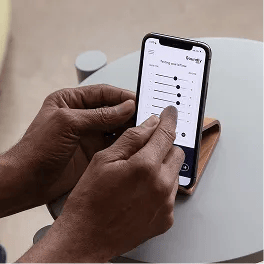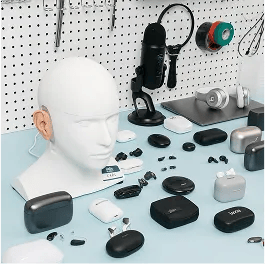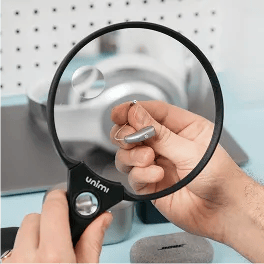.jpg)
When I sat down to research hearing aids for the first time, it took me hours to figure out what questions to ask. As the saying goes, I didn't know what I didn't know.
Years later, hearing health is now what I spend most days thinking about. I have more knowledge, but I also know what questions are important. So think of this guide as a research guide to my former self.
This guide is organized as a step-by-step research process, with links to recommended resources and videos along the way.
This crash course is designed to take about 60 minutes. Grab your headphones (you’ll need them for a quick hearing test), and let’s dive in!
First stop, know your hearing loss.
(10 minutes)
Before diving into hearing aid brands or technology, it’s important to understand your hearing profile. If you haven’t taken a hearing test yet, start with our five-minute test here.
Once you complete the test, you’ll receive your results by email—along with a chart showing your hearing loss across different frequencies.
If you have a hearing test in-hand, you can skip this step.
Next, let's review the results.
(10 minutes)
With your hearing test complete, it's time to get familiar with the results. I suggest watching the video below. If you are in a hurry, you can jump to 2:30 where the video discusses typical hearing loss patterns. See if you can spot your hearing loss shape (I have a cookie-bite). You can also read more about types of hearing loss here.
Consider your care model.
(10 minutes)
Now that you understand your hearing loss, it’s time to think about how you want to receive care. Why focus on the care model before diving into technology? Because the path you choose will directly shape which types and brands of hearing aids are available to you.
You have two main options:
Option #1 Prescription
This route involves visiting a local hearing care provider who will conduct a hearing test and use in-clinic software to program your hearing aids to match your hearing profile.
- Best for severe or profound hearing loss
- Most personalized care with in-person support
- Access to in-clinic brands like Phonak, Oticon, and Signia
- Typically cost $3,000–$8,000 per pair
Option #2: Over-the-Counter (OTC)
If you have mild to moderate hearing loss and are comfortable using a smartphone, OTC hearing aids could be a great fit. These devices are self-fit and controlled via an app—no clinic required.
- Available online with modern benefits like 45-day returns and fast delivery
- Convenient setup from home
- Limited to mild–moderate hearing loss
- Access to brands like Sony, Sennheiser and Nuance Audio
- Typically cost $500–$999 per pair
Want to dive deeper into this decision? Spend five minutes with this video for a full breakdown.
Time to choose a hearing aid style (10 minutes)
Hearing aids come in three main styles.
- Receiver-in-Canal (RIC): Sits behind the ear with a small speaker placed in the ear canal. Chosen by about 80% of users for its comfort, durability, and access to advanced technology like Bluetooth streaming.
- In-the-ear (CIC or ITE): Preferred by roughly 20% of users for their discreet look and compatibility with glasses, masks, and industrial hearing protection.
- Implanted options: For those with profound hearing loss, devices like cochlear implants or bone conduction implants may be recommended.
Take a few minutes to watch this video to learn more about styles and jot down the style that sounds right for you.
Create a product shortlist.
(15 minutes)
You’re 45 minutes into this crash course—and now it’s time to start building your personal hearing aid shortlist. All the upfront work you’ve done will make this part much easier.
Below you will find some of our regularly updated product guides which cover all of the latest technology and brands across care methods.
Best Overall Hearing Aids | Best Invisible Hearing Aids | Best OTC Hearing Aids | Best Affordable Hearing Aids
You can also watch our recent video breaking down our favorite products and brands below.
Final Thoughts
If you’ve made it this far—nicely done! By now, you should have:
- A hearing test in hand
- Notes on your personal preferences
- A sense of your ideal care model and hearing aid style
- And maybe even a shortlist of brands to explore
Still have questions? You’re not alone—and we’re here to help. This site is packed with resources on everything from tinnitus-friendly devices to hearing aids designed for musicians and the newest styles like Nuance Audio Glasses.
Use the search bar in the top right corner to find specific topics, or take our hearing health quiz to get a personalized recommendation.
And if you’d rather talk it through, give us a call or text us at 1-833-SOUNDLY. Our team is happy to help you figure it all out. You can also email us anytime at [email protected].
We hope this 60-minute crash course gave you the confidence to take your next step. We’re cheering you on.





